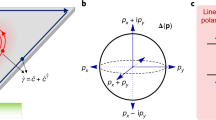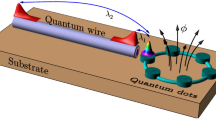Abstract
Spin–orbit coupling is an essential mechanism underlying quantum phenomena such as the spin Hall effect and topological insulators1. It has been widely studied in well-isolated Hermitian systems, but much less is known about the role dissipation plays in spin–orbit-coupled systems2. Here we implement dissipative spin–orbit-coupled bands filled with ultracold fermions, and observe parity-time symmetry breaking as a result of the competition between the spin–orbit coupling and dissipation. Tunable dissipation, introduced by state-selective atom loss, enables us to tune the energy gap and close it at the critical dissipation value, the so-called exceptional point3. In the vicinity of the critical point, the state evolution exhibits a chiral response, which enables us to tune the spin–orbit coupling and dissipation dynamically, revealing topologically robust chiral spin transfer when the quantum state encircles the exceptional point. This demonstrates that we can explore non-Hermitian topological states with spin–orbit coupling.
This is a preview of subscription content, access via your institution
Access options
Access Nature and 54 other Nature Portfolio journals
Get Nature+, our best-value online-access subscription
$29.99 / 30 days
cancel any time
Subscribe to this journal
Receive 12 print issues and online access
$209.00 per year
only $17.42 per issue
Buy this article
- Purchase on Springer Link
- Instant access to full article PDF
Prices may be subject to local taxes which are calculated during checkout




Similar content being viewed by others
Data availability
The data that support the findings of this work are available from the corresponding authors upon reasonable request.
Change history
28 January 2022
In the version of the Supplementary Information originally published, there was a typo in the caption to Figure S1. The error has been amended and the Supplementary Information now replaced.
References
Hasan, M. & Kane, C. Colloquium: topological insulators. Rev. Mod. Phys. 82, 3045 (2010).
Ashida, Y., Gong, Z. & Ueda, M. Non-Hermitian physics. Adv. Phy. 69, 249–435 (2020).
Miri, M.-A. & Alu, A. Exceptional points in optics and photonics. Science 363, eaar7709 (2019).
Xu, Y., Wang, S.-T. & Duan, L.-M. Weyl exceptional rings in a three-dimensional dissipative cold atomic gas. Phys. Rev. Lett. 118, 045701 (2017).
Gong, Z. et al. Topological phases of non-Hermitian systems. Phys. Rev. X 8, 031079 (2018).
Yao, S., Song, F. & Wang, Z. Non-Hermitian Chern bands. Phys. Rev. Lett. 121, 136802 (2018).
Helbig, T. et al. Generalized bulk-boundary correspondence in non-Hermitian topoelectrical circuits. Nat. Phys. 16, 747–750 (2020).
Xiao, L. et al. Non-Hermitian bulk-boundary correspondence in quantum dynamics. Nat. Phys. 16, 761–766 (2020).
Weidemann, S. et al. Topological funneling of light. Science 368, 311–314 (2020).
Lin, Y.-J., Jimenez-Garcia, K. & Spielman, I. B. Spin–orbit-coupled Bose–Einstein condensates. Nature 471, 83–86 (2011).
Wang, P. et al. Spin–orbit coupled degenerate Fermi gases. Phys. Rev. Lett. 109, 095301 (2012).
Cheuk, L. W. et al. Spin-injection spectroscopy of a spin–orbit coupled Fermi gas. Phys. Rev. Lett. 109, 095302 (2012).
Huang, L. et al. Experimental realization of two-dimensional synthetic spin–orbit coupling in ultracold Fermi gases. Nat. Phys. 12, 540–544 (2016).
Wu, Z. et al. Realization of two-dimensional spin-orbit coupling for Bose-Einstein condensates. Science 354, 83–88 (2016).
Song, B. et al. Observation of symmetry-protected topological band with ultracold fermions. Sci. Adv. 4, eaao4748 (2018).
Song, B. et al. Observation of nodal-line semimetal with ultracold fermions in an optical lattice. Nat. Phys. 15, 911–916 (2019).
Wang, Z.-Y. et al. Realization of an ideal Weyl semimetal band in a quantum gas with 3D spin-orbit coupling. Science 372, 271–276 (2021).
Yamamoto, K. et al. Theory of non-Hermitian fermionic superfluidity with a complex-valued interaction. Phys. Rev. Lett. 123, 123601 (2019).
Lazarides, A., Roy, S., Piazza, F. & Moessner, R. Time crystallinity in dissipative Floquet systems. Phys. Rev. Res. 2, 022002 (2020).
Luo, X.-W. & Zhang, C. Higher-order topological corner states induced by gain and loss. Phys. Rev. Lett. 123, 073601 (2019).
Xu, H., Mason, D., Jiang, L. & Harris, J. G. E. Topological energy transfer in an optomechanical system with exceptional points. Nature 537, 80–83 (2016).
Doppler, J. et al. Dynamically encircling an exceptional point for asymmetric mode switching. Nature 537, 76–79 (2016).
Hassan, A. U. et al. Chiral state conversion without encircling an exceptional point. Phys. Rev. A 96, 052129 (2017).
Wiersig, J. Enhancing the sensitivity of frequency and energy splitting detection by using exceptional points: application to microcavity sensors for single-particle detection. Phys. Rev. Lett. 112, 203901 (2014).
Liertzer, M. et al. Pump-induced exceptional points in lasers. Phys. Rev. Lett. 108, 173901 (2012).
Zhen, B. et al. Spawning rings of exceptional points out of Dirac cones. Nature 525, 354–358 (2015).
Zhao, H. et al. Non-Hermitian topological light steering. Science 365, 1163–1166 (2019).
Minganti, F., Miranowicz, A., Chhajlany, R. W. & Nori, F. Quantum exceptional points of non-Hermitian Hamiltonians and Liouvillians: the effects of quantum jumps. Phys. Rev. A 100, 062131 (2019).
Xiao, L. et al. Observation of topological edge states in parity-time-symmetric quantum walks. Nat. Phys. 13, 1117–1123 (2017).
Ozturk, F. E. et al. Observation of a non-Hermitian phase transition in an optical quantum gas. Science 372, 88–91 (2021).
Naghiloo, M., Abbasi, M., Joglekar, Y. N. & Murch, K. W. Quantum state tomography across the exceptional point in a single dissipative qubit. Nat. Phys. 15, 1232–1236 (2019).
Wu, Y. et al. Observation of parity-time symmetry breaking in a single-spin system. Science 364, 878–880 (2019).
Gao, T. et al. Observation of non-Hermitian degeneracies in a chaotic exciton-polariton billiard. Nature 526, 554–558 (2015).
Li, J. et al. Observation of parity-time symmetry breaking transitions in a dissipative Floquet system of ultracold atoms. Nat. Commun. 10, 855 (2019).
Takasu, Y. et al. PT-symmetric non-Hermitian quantum many-body system using ultracold atoms in an optical lattice with controlled dissipation. Prog. Theor. Exp. Phys. 2020, ptaa094 (2020).
Liu, W., Wu, Y., Duan, C.-K., Rong, X. & Du, J. Dynamically encircling an exceptional point in a real quantum system. Phys. Rev. Lett. 126, 170506 (2021).
Kofman, A. G. & Kurizki, G. Acceleration of quantum decay processes by frequent observations. Nature 405, 546–550 (2000).
Mailybaev, A. A., Kirillov, O. N. & Seyranian, A. P. Geometric phase around exceptional points. Phys. Rev. A 72, 014104 (2005).
Uzdin, R., Mailybaev, A. & Moiseyev, N. On the observability and asymmetry of adiabatic state flips generated by exceptional points. J. Phys. A Math. Theor. 44, 435302 (2011).
Wu, J. H., Artoni, M. & Rocca, G. C. L. Non-Hermitian degeneracies and unidirectional reflectionless atomic lattices. Phys. Rev. Lett. 113, 123004 (2014).
Yoon, J. W. et al. Time-asymmetric loop around an exceptional point over the full optical communications band. Nature 562, 86–90 (2018).
Daley, A. J. Adv. Phys. 63, 77 (2014).
Zhou, L., Yi, W. & Cui, X. Dissipation-facilitated molecules in a Fermi gas with non-Hermitian spin-orbit coupling. Phys. Rev. A 102, 043310 (2020).
Deffner, S. & Saxena, A. Jarzynski equality in PT-symmetric quantum mechanics. Phys. Rev. Lett. 114, 150601 (2015).
Kawabata, K., Ashida, Y. & Ueda, M. Information retrieval and criticality in parity-time-symmetric systems. Phys. Rev. Lett. 119, 190401 (2017).
Acknowledgements
G.-B.J. acknowledges support from the RGC and the Croucher Foundation through grants nos. 16305317, 16304918, 16306119, 16302420, C 6005-17G and N-HKUST601/17. G.-B.J is further supported by the Harilela foundation. J.L. acknowledges support from the RGC through grants nos. 16304520 and C6013-18G.
Author information
Authors and Affiliations
Contributions
Z.R., E.Z., C.H. and K.K.P. carried out the experiment and data analysis and helped with numerical calculations. D.L. performed theoretical calculations. G.-B.J. and J.L. and supervised the research.
Corresponding authors
Ethics declarations
Competing interests
The authors declare no competing interests
Peer review
Peer review information
Nature Physics thanks Wei Yi and the other, anonymous, reviewer(s) for their contribution to the peer review of this work.
Additional information
Publisher’s note Springer Nature remains neutral with regard to jurisdictional claims in published maps and institutional affiliations.
Supplementary information
Supplementary Information
Supplementary Figs. 1–6 and Discussion.
Rights and permissions
About this article
Cite this article
Ren, Z., Liu, D., Zhao, E. et al. Chiral control of quantum states in non-Hermitian spin–orbit-coupled fermions. Nat. Phys. 18, 385–389 (2022). https://doi.org/10.1038/s41567-021-01491-x
Received:
Accepted:
Published:
Issue Date:
DOI: https://doi.org/10.1038/s41567-021-01491-x
This article is cited by
-
Collective non-Hermitian skin effect: point-gap topology and the doublon-holon excitations in non-reciprocal many-body systems
Communications Physics (2024)
-
Non-Hermitian chiral degeneracy of gated graphene metasurfaces
Light: Science & Applications (2023)
-
Topological non-Hermitian skin effect
Frontiers of Physics (2023)
-
An exceptional mass dance
Nature Physics (2022)
-
Engineering non-Hermitian skin effect with band topology in ultracold gases
Communications Physics (2022)



